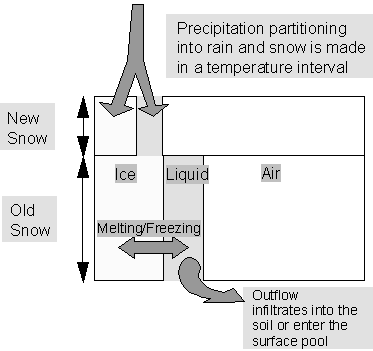Snow Dynamics
Snow conditions are considered both as a water storage and boundary condition for soil water flows and as an important factor influencing the soil heat boundary condition. Precipitation is divided into rain and snow, depending on the values assigned to threshold parameters. Melting of snow is based on global radiation, air temperature and the heat flux from the soil. The melting caused by global radiation is to some extent controlled by snow age. Liquid water retained in the snow can also refreeze. The thermal conductivity of snow is estimated from snow density. During melting the soil surface temperature is put to 0. The energy balance calculations of the snow surface are used to estimate snow surface temperature and sensible and latent heat fluxes, but these fluxes are not incorporated in the present mass balance of the model. The heat storage of snow is not explicit in the present snow model

Figure 4.2. The snow model, subdivision of snow into two compartments and the different water flow paths.
Snow is separated into liquid water and the total water equivalent. The entire snow pack is considered to be homogeneous both horizontally and vertically. The mass balance of the snow pack can be calculated using either an empirical melting/freezing function or an energy balance approach taking the heat balance of the snow pack into account, as determined by the switch SnowMeltFunction. The liquid water will (in both cases) control both the mass balance and the outflow from the snow but also the density and the thermal properties of the snow. This is described below.
 Empirical Melting/Freezing Function
Empirical Melting/Freezing Function
 Energy balance Melting/Freezing
Function
Energy balance Melting/Freezing
Function
 Surface energy balance of snow
Surface energy balance of snow
 Fraction of snow free vegetation
Fraction of snow free vegetation
 Adjusting to measured snow depths
Adjusting to measured snow depths